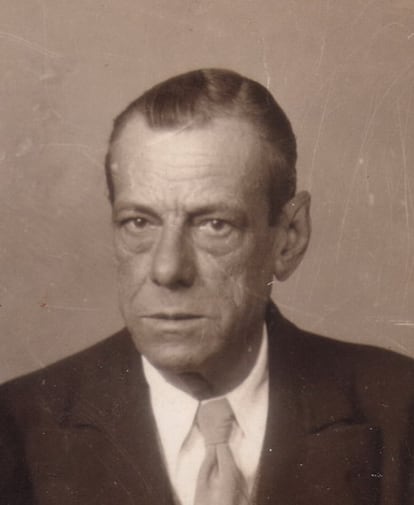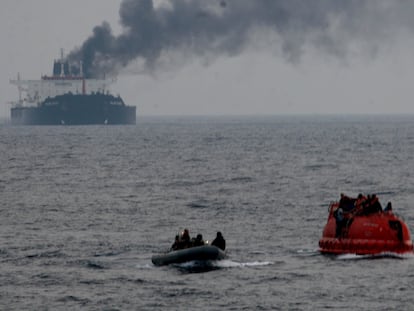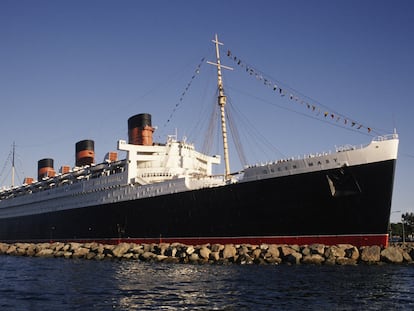The mysterious and forgotten shipwreck of the ‘Spanish Titanic’ off the coast of Brazil
The ocean liner ‘Príncipe de Asturias’ sank in 1916, killing at least 445 people without counting all the clandestine passengers. A survivor believed the wreck might have been intentional and tied to undeclared cargo rumored to be gold


Isidor Prenafeta Siles, 87, still remembers the after-dinner conversations of his youth, in 1940s Spain, when his grandfather would recount the thrilling tale of the shipwreck, if there was company to listen. “The story of the ship would come up here and there in conversation, but only when guests asked him about it,” he remembers, speaking on the phone from his home in Castelldefels, a coastal town on the outskirts of Barcelona. “I would ask him about it, too,” says Siles, a retired engineer and a writer who made his living building boats. His grandfather, Gregorio Siles Peña, would recount in gripping detail the fatal wreck of the Príncipe de Asturias, the Spanish passenger liner that sank off the coast of Brazil, on the night of Carnaval, in 1916. Siles Peña knew the details because he was there: he survived the catastrophe.
Peña worked as an electrician on the ship, which was launched just two weeks after a similarly fated, if more famous, passenger liner — the RMS Titanic — struck an iceberg and capsized in the North Atlantic Ocean on the night on April 14, 1912. The pride of the Spanish merchant navy, built in Scotland, the Príncipe de Asturias departed Barcelona on February 17, 1916, bound for Buenos Aires, on what would be her last and final voyage. More than a century later, the tragedy of the “Spanish Titanic” (or the “Brazilian Titanic,” depending on who you ask) is better known in Brazil, where it sank, than in Spain, where it set sail. The remains of the shipwreck, which claimed more lives than any other in the history of Latin America’s largest country, still lie in the depths of the South Atlantic.
March 5, 1916: The night of Carnaval, and the last night before the Príncipe’s scheduled stopover in Brazil. First-class passengers are enjoying their own carnival celebration, dancing the Charleston to a live orchestra on the 150-meter-long ship, which in addition to a dancefloor, offered its wealthier guests a library, a sauna and a smoking lounge. Registered passengers totaled 654, including 193 crew members, but historians estimate that somewhere in the realm of 1,000 additional, clandestine travelers were also aboard: European refugees fleeing the devastation of World War I, packed into the ship’s hold, together with a slew of delinquents of all shapes and stripes — men and women in search of a new life in America.
When the ship capsized, Siles Peña managed to jump into the sea, keeping himself afloat by holding onto a wooden crate, and eventually washed up on an island in the Ilhabela archipelago off the coast of the Brazilian state of São Paulo. It would be a week before he was rescued.

The clandestine passengers were never included in the official death toll: 445 casualties, with 143 people rescued. “Considering the number of victims,” says Daniel Gusmão, Lieutenant Commander of the Brazilian Navy’s Historical Heritage and Documentation Directorate, speaking by phone from Rio de Janeiro, “there is no doubt that the incident was the most deadly of all the roughly 2,000 shipwrecks of historical interest documented along Brazil’s coast during the last five centuries of the Navy’s recorded history.”
The story of the Príncipe de Asturias that survives to the present day is a combination of known facts, unproven theories, and a wide range of conjectures, collected in a handful of books published on either side of the Atlantic. An investigation conducted 106 years ago by the Lloyds Insurance Company failed to determine what caused the ship to run afoul, and it remains an enigma to this day.
That night, the story goes, the ship’s passengers were in the mood to party. Not only was it Carnaval, but the next morning they would arrive at the Port of Santos, in the state of São Paulo. Two days later, the remaining passengers would be in Montevideo; in three, Buenos Aires. But that night, a torrential storm brought heavy rain and a thick layer of fog, which prevented the Ponta do Boi lighthouse from guiding the ship along the shore. The Príncipe de Asturias veered dangerously close to the coastline and at 4am it collided with some shoals, which gouged a massive hole in the liner’s hull. The steam engine exploded. The bow plunged headfirst into the water, and within five minutes the entire ship was consumed by the sea. The crew barely had enough time to deploy a single lifeboat. The ship had a state-of-the-art telegraph machine, but the disaster struck so suddenly, there was no time to send an SOS.
As it traversed the Barcelona-Buenos Aires route, the steamship carried some 40 million pounds sterling in gold — a payment from the British government to Argentina for wartime food supplies. It was also transporting thousands of sacks of transatlantic mail, stores of French liquor, and eight statues for a monument to Spaniard colonists, set to be erected in the Argentine capital. But crewman Siles, who dedicated much of his retirement to investigating the mystery of the shipwreck, suspected, despite the shipping company’s disinterest, that there was more undeclared cargo in the boat’s hold: another large shipment of gold. “There were rumors that the ship was carrying some 11 tons of gold, to open a Spanish bank in Buenos Aires,” says his grandson Isidor, reflecting on his grandfather’s suspicion, which was never confirmed.
“He thought the wreck might have been intentional, and that it had to to with the Captain’s disappearance,” Prenafeta Siles says. According to his grandson, Siles Peña said that on the night of the tragedy, he and another crew member witnessed a strange and suspicious incident: In the middle of the storm, a small cargo ship appeared alongside the Príncipe, and several boxes of unknown contents were unloaded onto the mysterious boat.
One element of the ocean liner’s storied demise that continues to inspire interest and conjectures, is that the ship’s captain, José Lotina, was reported missing even before the disaster struck. He was never heard from again. His body was never found, and he was not counted among the survivors. The shipwreck was front page news in the Brazilian press, which followed the rescue and recovery of survivors and victims for days after the incident. It also made headlines halfway around the world. Prenafeta Siles says that at the time, “there were a lot of wild stories, like that the captain had shot himself, or that the ship was sunk by a German torpedo.”

He tells the story of the shipwreck in his book, El misterio del Príncipe de Asturias, el Titanic español (Noray), recounting how he took three trips to the Ilhabela archipelago, following the footsteps of his maternal grandfather, who had spent a week on a deserted island there, alone with one other survivor, eating limpets on a beach surrounded by dense vegetation.
Decades later, on that same Brazilian island, Prenafeta Siles would meet the man responsible for the Príncipe de Asturias’s fame in Brazil: the diver and researcher Jeannis Platon, who declined multiple requests to be interviewed for this story. The two men would become close friends and collaborators.
Platon, the author of several books on shipwrecks, who opened a museum in the Ilhabela archipelago’s eponymous city, was born in Greece, but has lived in Brazil since he was a teenager. He is convinced that the area around Ilhabela is Brazil’s own Bermuda Triangle, because the earth has a high concentration of iron that can confuse compasses. This, he says, is why the area is a veritable cemetery of sunken ships. Over the course of two decades, Platon made numerous underwater excursions to study the remains of the famed Spanish ship. He invested many years and a lot of money in his quest to learn every detail of that fateful carnival night, ultimately compiling his findings in the book Príncipe de Asturias, um mistério entre dois continentes (available in Portuguese).
Platon was able to rescue one of the ship’s sunken statues, preserved in the Naval Museum in Río de Janeiro. And then there’s the treasure trove of history still lying at the bottom of the sea. Lieutenant Commander Gusmão emphasizes that “every shipwreck is its own time capsule.” Which is why, he says, it’s so important to prevent looting. “These sites can and should be researched by marine archaeologists because, with the right techniques, they can find new clues to help us understand what happened.” A few years ago, the Brazilian Navy produced a map of shipwrecks of historical interest along its coastline — a 7,500 kilometer stretch nicknamed “the blue Amazon” — with the intention of raising awareness about the historical value of shipwrecks, assisting in the auditing of these sites, and keeping treasure hunters at bay.
The tragedy of the Príncipe de Asturias also had its hero. Actually, a heroine. Marina Vidal, a 26-year-old Spanish jewelry saleswoman, who was traveling on the ship in first class. An excellent swimmer, Vidal managed to rescue at least four people, including the only Brazilian national on board.
Tu suscripción se está usando en otro dispositivo
¿Quieres añadir otro usuario a tu suscripción?
Si continúas leyendo en este dispositivo, no se podrá leer en el otro.
FlechaTu suscripción se está usando en otro dispositivo y solo puedes acceder a EL PAÍS desde un dispositivo a la vez.
Si quieres compartir tu cuenta, cambia tu suscripción a la modalidad Premium, así podrás añadir otro usuario. Cada uno accederá con su propia cuenta de email, lo que os permitirá personalizar vuestra experiencia en EL PAÍS.
¿Tienes una suscripción de empresa? Accede aquí para contratar más cuentas.
En el caso de no saber quién está usando tu cuenta, te recomendamos cambiar tu contraseña aquí.
Si decides continuar compartiendo tu cuenta, este mensaje se mostrará en tu dispositivo y en el de la otra persona que está usando tu cuenta de forma indefinida, afectando a tu experiencia de lectura. Puedes consultar aquí los términos y condiciones de la suscripción digital.
More information

How two ex-cops cracked a $100 million maritime mystery
Últimas noticias
Most viewed
- Sinaloa Cartel war is taking its toll on Los Chapitos
- Reinhard Genzel, Nobel laureate in physics: ‘One-minute videos will never give you the truth’
- Oona Chaplin: ‘I told James Cameron that I was living in a treehouse and starting a permaculture project with a friend’
- Why the price of coffee has skyrocketed: from Brazilian plantations to specialty coffee houses
- David King, chemist: ‘There are scientists studying how to cool the planet; nobody should stop these experiments from happening’









































